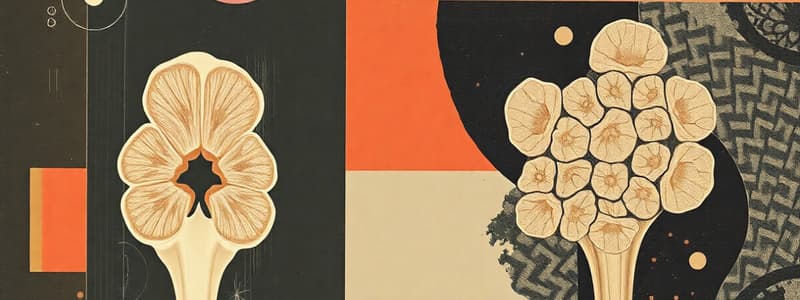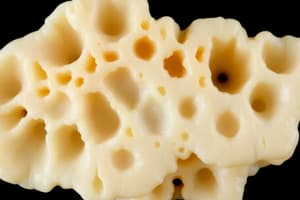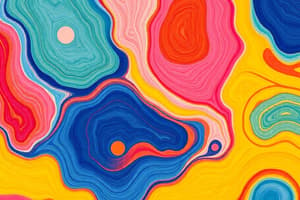Podcast
Questions and Answers
What is the primary mechanism through which interstitial growth occurs in cartilage?
What is the primary mechanism through which interstitial growth occurs in cartilage?
- Reduction of extracellular matrix due to aging
- Division of chondrocytes and synthesis of extracellular matrix (correct)
- Division of fibroblasts in the perichondrium
- Inflammatory responses leading to matrix reabsorption
Which of the following statements about appositional growth is true?
Which of the following statements about appositional growth is true?
- It begins and ends during strict childhood.
- It involves the differentiation of cells in the perichondrium into chondrocytes. (correct)
- It leads to a decrease in the overall width of cartilage.
- It occurs primarily at the inner surface of cartilage.
Which process is primarily responsible for the rapid increase in size during the healing of cartilage?
Which process is primarily responsible for the rapid increase in size during the healing of cartilage?
- Apoptosis of older chondrocytes
- Reduction in matrix viscosity
- Inflammatory response leading to matrix growth
- Division of chondrocytes and deposition of matrix (correct)
During which stage of development does interstitial growth of cartilage primarily occur?
During which stage of development does interstitial growth of cartilage primarily occur?
How does appositional growth contribute to the overall structure of cartilage?
How does appositional growth contribute to the overall structure of cartilage?
Which type of cartilage is most abundant and provides flexibility at joints?
Which type of cartilage is most abundant and provides flexibility at joints?
What is the primary role of the perichondrium in relation to cartilage?
What is the primary role of the perichondrium in relation to cartilage?
Which characteristic differentiates fibrocartilage from other types of cartilage?
Which characteristic differentiates fibrocartilage from other types of cartilage?
What happens to cartilage when a load is removed?
What happens to cartilage when a load is removed?
What is the significance of the 'molecular sponge' nature of proteoglycans in cartilage?
What is the significance of the 'molecular sponge' nature of proteoglycans in cartilage?
Which type of cartilage is primarily involved in the development and growth of long bones?
Which type of cartilage is primarily involved in the development and growth of long bones?
What impact does adulthood have on the healing ability of cartilage?
What impact does adulthood have on the healing ability of cartilage?
What type of cells produce the extracellular matrix in cartilage?
What type of cells produce the extracellular matrix in cartilage?
What type of collagen is mainly found in the meshwork of cartilage?
What type of collagen is mainly found in the meshwork of cartilage?
Which statement accurately represents the characteristics of hyaline cartilage?
Which statement accurately represents the characteristics of hyaline cartilage?
Which layer of cartilage is known for being avascular?
Which layer of cartilage is known for being avascular?
What is the function of chondrocytes in cartilage?
What is the function of chondrocytes in cartilage?
During which pattern does cartilage growth typically occur?
During which pattern does cartilage growth typically occur?
Which property is highest in fibrocartilage among the cartilage types?
Which property is highest in fibrocartilage among the cartilage types?
How does the structure of elastic cartilage differ from hyaline cartilage?
How does the structure of elastic cartilage differ from hyaline cartilage?
Flashcards
Interstitial growth
Interstitial growth
Growth of cartilage from within, involving division of chondrocytes and deposition of new extracellular matrix. Occurs during childhood and adolescence.
Appositional growth
Appositional growth
Growth of cartilage from the outside, involving differentiation of perichondrial cells into chondroblasts, which then produce new matrix.
Healing & repair of cartilage
Healing & repair of cartilage
Process by which damaged cartilage is repaired. Includes both interstitial and appositional growth.
Cartilage
Cartilage
Signup and view all the flashcards
Chondroblasts
Chondroblasts
Signup and view all the flashcards
Ground Substance
Ground Substance
Signup and view all the flashcards
Hyaline Cartilage
Hyaline Cartilage
Signup and view all the flashcards
Fibrocartilage
Fibrocartilage
Signup and view all the flashcards
Elastic Cartilage
Elastic Cartilage
Signup and view all the flashcards
Chondrocytes
Chondrocytes
Signup and view all the flashcards
Lacunae
Lacunae
Signup and view all the flashcards
Collagen Meshwork
Collagen Meshwork
Signup and view all the flashcards
Proteoglycans
Proteoglycans
Signup and view all the flashcards
Perichondrium
Perichondrium
Signup and view all the flashcards
Cartilage Growth & Repair
Cartilage Growth & Repair
Signup and view all the flashcards
Cartilage Nutrition
Cartilage Nutrition
Signup and view all the flashcards
Cartilage Resistance
Cartilage Resistance
Signup and view all the flashcards
Articular Cartilage Loading
Articular Cartilage Loading
Signup and view all the flashcards
Study Notes
Cartilage Overview
- Cartilage is a specialized connective tissue, supporting soft tissues, providing a smooth surface for joints, and enabling long bone development.
- It's composed of a dense network of collagen fibers embedded in chondroitin sulfate—a gel-like ground substance.
- Cartilage withstands more stress than loose and dense connective tissues.
- Cartilage types differ in their collagen fiber arrangement, presence of perichondrium, and strength.
Cartilage Types and Features
-
Hyaline cartilage: Thin, fine collagen fibers, prominent chondrocytes in lacunae, most hyaline cartilage is surrounded by perichondrium (except articular cartilage, which is in joints and epiphyseal plates). It provides flexibility and support, reducing friction and absorbing shock in joints. It's the weakest of the three.
-
Fibrocartilage: Thicker bundles of collagen fibers, chondrocytes scattered throughout, lacks perichondrium, strong and rigid. It offers support and maintains shape
-
Elastic cartilage: Threadlike network of elastic fibers, chondrocytes located within the extracellular matrix, perichondrium is present, support and shape maintenance (elasticity). It's the second strongest.
Cartilage Roles
- Support for soft tissues.
- Smooth, gliding surface for bone articulations at joints.
- Development and growth of long bones.
Cartilage Classification
- Information on cartilage classification was presented as a diagram, not text.
Cartilage Components
-
Cells:
- Chondroblasts: immature cells, produce extracellular matrix
- Chondrocytes: mature cells, maintain extracellular matrix. Cells can be found singly or in groups within lacunae (small spaces in the matrix).
-
Fibers:
- Meshwork of collagen (mainly Type 2). Collagen arrangement strengthens and holds the gel-like ground substance.
-
Ground substance: Proteoglycans, complex macromolecules with core proteins attached to glycosaminoglycans (GAGs). Proteoglycans help bind water, creating a "molecular sponge," and allowing cartilage to function properly.
Cartilage Loading
- Onloading: Fluid pressure rises, cartilage deforms, water moves out—similar to squeezing a wet sponge.
- After removal of load: Fluid pressure drops, cartilage returns to normal shape.
Cartilage Zones (Collagen Arcade)
- Superficial horizontal collagen fibers (superficial tangential, middle, and deep zones).
- Intermediate layer (collagen arcade).
- Deep vertical collagen fibers
Cartilage Nutrition
- Articular cartilage receives nutrition through diffusion from underlying subchondral bone, synovial membrane at the cartilage periphery, and synovial fluid in the joint.
Perichondrium
- A layer of dense connective tissue surrounding most cartilage surfaces.
- Articular cartilage (and some hyaline cartilage) lacks perichondrium.
Cartilage Healing & Repair
-
Cartilage is relatively inactive and grows slowly.
-
Cartilage has low regeneration ability, mainly in young individuals due to its avascular nature.
-
In adults, damage leads to fibrous scar tissue formation lacks hyaline cartilage properties.
-
Growth patterns:
- Interstitial growth: Occurs in young, pliable cartilage during childhood and adolescence
- Appositional growth: Occurs later and continues in adulthood.
Other information
- Information on further reading was provided.
Studying That Suits You
Use AI to generate personalized quizzes and flashcards to suit your learning preferences.




